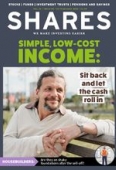Archived article
Please note that tax, investment, pension and ISA rules can change and the information and any views contained in this article may now be inaccurate.
Simple, low-cost income: sit back and let the cash roll in

The rapid growth of exchange traded funds over the last decade means investors now have plenty of choice when tracking major investment themes.
ETFs take the headache and risk out of trying to pick the best active managers while also offering lower costs and good liquidity. They can also provide diversification in certain assets which are harder for retail investors to access such as bonds, property and infrastructure.
In this feature we explain how to go about building a portfolio of ETFs designed to achieve a good income while also providing some growth. It is aimed at investors close to retirement looking to build and supplement their incomes.
The UK market offers one of the highest dividend yields among developed markets, so it might seem tempting just to purchase a FTSE 100 index tracker such as the iShares Core FTSE 100 ETF (ISF), and pick up a yield upwards of 3%.
However, there is always the risk that dividends are cut, as happened brutally in 2020, particularly given economic uncertainty remains elevated as inflationary pressures rise and central banks start to remove economic stimulus.
Therefore, it makes sense to look beyond shares and reduce risk by investing for income across other asset classes.
Property and infrastructure funds provide some inflation protection and bonds provide more certain income than equities.
Expanding the source of income should increase the durability of the portfolio and provide stable income in different economic environments.
Stable Income
Bonds are a natural source of stable income because their returns are contractual. They have limited upside but are better protected on the downside. When companies issue debts, known as bonds, they are legally required to service those debts and pay back the loan.
This means bond investors get priority treatment over shareholders. A company is much more likely to cut or fail to pay a discretionary dividend than to skip the coupon payment on a bond. In a worst case scenario where a company fails to service its loans, bond holders can take control of a company and sell off its assets to recover what’s owed to them.
Although retail investors can purchase individual bonds issued by companies on the London Stock Exchange, the minimum sizes can be prohibitive, and the skills and specific knowledge required to properly assess the risks can be daunting.
Therefore, investing through an ETF makes sense and there are plenty to choose from. However, remember to choose a distributing share class so that income is paid out and a sterling denominated class to remove exchange rate risk if the fund invests overseas.
We have focused on corporate bonds because they have higher yields rather than government bonds which pay next to nothing in interest in the current environment.
Global Equities
Share-based ETFs that track higher yielding stocks across various indices can be a good source of income. It is important not to simply focus on funds with the highest yields because the underlying dividends may not be as sustainable.
Therefore, when searching for high dividend share ETFs, check the rules used by the manager to select shares for the fund.
Products which use quality factors that consider balance sheet and cash flow characteristics are more likely to deliver a stable income. In other words, it is often better to give up some yield to increase durability. Another advantage is that quality shares are more likely to grow their dividends.
Adding global market exposure increases diversification. There is always one part of the world doing better which you will get exposure to through selecting a global product.
It is also possible to increase the overall portfolio yield by investing a small portion in emerging markets. Most investors probably would not even consider investing in individual companies listed in some far-off land. Investing via a well-diversified ETF reduces that risk, although remember the management fees are often higher.
How income-based ETFs work
ETFs are normally set up for either income or accumulation. Income ETFs pay out distributions to holders as cash. Accumulation ETFs effectively reinvest the dividends for you. So, you need to make sure you buy the right version of the ETF if you want to receive the income as cash.
Some ETFs won’t offer a choice of income or accumulation versions of their fund. If there is no choice, it typically means any dividends will be paid out in cash.
Inflation protection
Rather than betting the farm on a few property companies, global property ETFs allow investors to track the performance of entire property markets while picking up a decent dividend yield.
Property has tended to do well in periods of rising inflation and therefore offer the prospect of the income maintaining its real value over time.
The same argument can be made for infrastructure funds which often have inflation clauses written into the contract allowing them
to pass on increased costs.
Investors get exposure to a broad range of industries with stable cash flows ranging from water and electricity companies to transportation and communications firms.
Simple, low-cost income picks
SPDR S&P UK Dividend Aristocrats (UKDV) £11.02
Yield: 3.6%
Our rationale for selecting UK Dividend Aristocrats (UKDV) is that this product not only offers a decent yield, with distributions paid out twice a year, it also invests in resilient, cash-generators with formidable dividend track records.
The ETF tracks the S&P UK High Yield Dividend Aristocrats index, which measures the performance of the UK’s 40 highest dividend-yielding companies within the S&P Europe Broad Market Index (BMI) that have also raised or maintained the shareholder reward for at least the last seven consecutive years, lending the portfolio attractive inflation-beating credentials.
With 39 holdings at last count, UK Dividend Aristocrats offers exposure to sectors such as financials, industrials, consumer staples and healthcare, with the top 10 ranging from insurers Phoenix (PHNX) and Legal & General (LGEN) to pharmaceuticals giant GlaxoSmithKline (GSK), cigarettes titan British American Tobacco (BATS) and defence outfit BAE Systems (BA.). [JC]
Vanguard High Dividend Yield ETF (VHYL) 48.15p
Yield: 3.4%
From the respected Vanguard stable, it’s been a go-to fund for years for investors seeking inexpensive and diversified exposure to income-generating stocks from around the world. With £4.8 billion under management, investors get access to 1,782 global stocks, such as microchips firm TSMC, bank JPMorgan Chase, Johnson & Johnson, Home Depot and Proctor & Gamble, its current biggest five.
About 45% of the fund is in US stocks, a bit more than a quarter in European, with the rest made up of mature and emerging markets. Paying dividends quarterly, the fund would have turned a £10,000 investment into £17,000 from inception in April 2013, including income, and ongoing charges are just 0.29%. [SF]
Invesco FTSE Emerging Markets High Dividend Low Volatility (EMHD) $29.93
Yield: 6.1%
The fund tracks the 100 least-volatile high dividend-yielding stocks in the FTSE Emerging Markets Index while at the same time meeting diversification, volatility and liquidity requirements.
Its aim is to generate an attractive yield – currently above 6% – by owning a broad spread of investments across various emerging markets which it can buy or sell without difficulty when required. Dividends are paid quarterly.
The fund is quoted in dollars, has roughly $106 million in assets and its biggest exposures are to China (48.5%) and Russia (12.8%), with smaller but significant exposure to Taiwan (8.5%) and Brazil (6.4%). [IC]
L&G ESG GBP Corporate Bond UCITS ETF (GBPC) 944.5p
Yield: 2.1%
The fund adds diversification and pays a higher rate of interest than government bonds without taking too much risk.
The manager invests in sterling denominated investment grade bonds across developed and emerging markets. It tracks the JP Morgan GCI ESG Investment Grade GBP Custom Maturity Index.
The index applies an ESG (environmental, social and governance) scoring system to tilt towards higher ranked issuers.
The fund is mainly exposed to UK companies which comprise 55.6% of the fund and US companies which make up a further 20%.
The fund is very competitive on price with an ongoing charge of nine basis points a year. Income is paid annually. (MGam]
VanEck Vectors Global Real Estate (TREG) £37.35
Yield: 2%
This fund pays out quarterly distributions derived from a basket of property-related stocks. As a ‘real’ asset, property tends to offer some protection against inflation, which is a big consideration given a backdrop of rapidly rising prices.
More than half the portfolio is in the US, while Japan is second with a 13.5% weighting. The biggest individual holding is San Francisco warehouse investor Prologis. The yield on the fund is 2%, while the ongoing charges are low for a real estate focused ETF at just 0.25%. It has generated 7.2% annualised returns over the past three years. [TS]
iShares Global Infrastructure (INFR) £24.46
Yield: 1.92%
The appeal of investing in infrastructure is clear. Assets such as ports, airports and toll roads are essential to the modern world and their revenue streams are long term in nature and less volatile with a link to inflation usually built in by regulation.
The ongoing charges for this fund, which invests in businesses with at least 65% of their revenue coming from infrastructure, are 0.65%. This is higher than you would find with mainstream equity ETF such as a FTSE 100 tracker because it reflects the greater complexities of investing in this space.
In relative terms it still offers inexpensive exposure to this asset class, with the average charge for infrastructure investment trusts running at more than 1% according to the Association of Investment Companies. Dividend distributions are made on a quarterly basis. [TS]
Important information:
These articles are provided by Shares magazine which is published by AJ Bell Media, a part of AJ Bell. Shares is not written by AJ Bell.
Shares is provided for your general information and use and is not a personal recommendation to invest. It is not intended to be relied upon by you in making or not making any investment decisions. The investments referred to in these articles will not be suitable for all investors. If in doubt please seek appropriate independent financial advice.
Investors acting on the information in these articles do so at their own risk and AJ Bell Media and its staff do not accept liability for losses suffered by investors as a result of their investment decisions.
Issue contents
Editor's View
Feature
Great Ideas
- Google-owner does the splits as it smashes Q4 expectations
- Grab a great buying opportunity in Gamma Communications
- Pets At Home's new CEO is a great hire and the shares are still a buy
- Our buy call on Shell is up nearly 20% in two weeks
- Take advantage of Smithson’s stumble and top up
- Virgin Wines’ share price slump looks overdone
- This value-tilted global fund is now outperforming

 magazine
magazine















